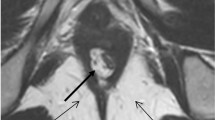Abstract
Different criteria have been used in literature to describe the anterior ectopic anus (AEA) anomaly, resulting in uncertainty over its prevalence, association with constipation and definition of the indications for surgery. It has been recently proposed that the term AEA should be restricted to anomalies in which a normal appearing anal orifice is located in the perineum in a more anterior location than normal, with an anal canal of normal calibre that is shown by electrical stimulation to be surrounded by the voluntary external anal sphincter (EAS). We report about four infants, three females and one male, who presented with constipation and had an anteriorly located anal orifice of normal calibre. The anal position index measured clinically was less than 0.34 in all the female patients and 0.44 in the male patient. In preoperative magnetic resonance imaging (MRI), the EAS was distributed all around the circumference of the anal canal, including the ventral aspect of the anal canal, in all the patients. Preoperative MRI documentation of sphincter distribution is recommended for the diagnosis of AEA, as it would help in better definition of its association with constipation and the results of surgical management.






Similar content being viewed by others
References
Schuster T, Joppich I, Schneider K, Jobst G (2000) A computerized vector manometry study of the so-called ectopic anus. Pediatr Surg Int 16:8–14
Reisner SH, Sivan Y, Nitzan M, Merlob P (1984) Determination of anterior displacement of the anus in newborn infants and children. Paediatrics 73:216–217
Bill AH, Johnson RJ, Foster RA (1958) Anteriorly placed rectal opening in the perineum. Ann Surg 147:173–179
Pena A (2004) Comment on anterior ectopic anus. Pediatr Surg Int 20:902
Harek O, Aziz P (2004) Incidence of anterior displacement of the anus and its relationship to constipation in children. Surg Today 34:190–192
Genc A, Taneli C, Tansung N, Kasigra E, Yilmaz D, Kucukoglu T et al (2002) Evaluation of the location of the anus by modified technique in the neonate. J Pediatr Surg 37:80–82
Kerremans RPJ, Penninckx FMA, Beckers JPV (1974) Functional evaluation of ectopic anus and its surgical consequences. Am J Dis Child 128:811–814
Schäfer A, Enck P, Fürst G, Kahn T, Frieling T, Lübke HJ (1994) Anatomy of the anal sphincters. Comparison of anal ultrasonography to magnetic resonance imaging. Dis Colon Rectum 37:777–781
Beets-Tan RGH, Beets GL, van der Hoop AG, Borstlap ACW, van Boven H, Rongen MJGM et al (1999) High-resolution magnetic resonance imaging of the anorectal region without an endocoil. Abdom Imaging 24:576–581
Kashyap P, Bates N (2004) Magnetic resonance imaging anatomy of the anal canal. Australas Radiol 48:443–494
Author information
Authors and Affiliations
Corresponding author
Rights and permissions
About this article
Cite this article
Thambidorai, C.R., Raghu, R. & Zulfiqar, A. Magnetic resonance imaging in anterior ectopic anus. Pediatr Surg Int 24, 161–165 (2008). https://doi.org/10.1007/s00383-007-2052-1
Accepted:
Published:
Issue Date:
DOI: https://doi.org/10.1007/s00383-007-2052-1




